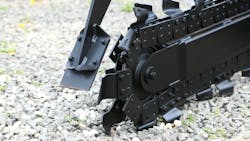This article has been updated.
It's easy to take the versatility and transportability of most chain trenchers for granted, but a little advance planning is necessary to make sure trenching is profitably productive.
"A lot of operators leave the yard not knowing what the day's job is going to look like — what kind of terrain they face, the underground obstacles, the soil conditions they will encounter," says Brent Bolay, senior product manager at Ditch Witch. "They don't have a chance to select the proper boom length for the depth of trench they need to dig or the proper teeth for the soil conditions. Those are things that could make them a lot more productive."
In addition to calling the local One Call service to locate existing utilities, a contractor motivated to get maximum production from trenching operations should check the soil conditions where trenches are to be dug, and look over the project requirements before going to work. That information is essential to making sure the trencher is set up to produce.
How to cut a turn with a trencher
Sharp turns with the trencher in the ground puts side pressure on the boom that will damage the machine. If plans call for a sharp turn, cut the primary trench to the turn. Pull the boom out of the ground and reposition it at the required angle far enough behind the primary trench to start the second trench. Dig deeper than designed depth, if possible, through the intersection with the primary trench. Spoil falling into the intersection will fill this void. If the pipe or duct you're burying is too rigid to make the turn, excavate the inside corner to leave space for a more-gradual turn.
How to fine-tune trencher speed
Full chain speed is rarely the most productive choice. To match ground speed and trencher-chain speed, run the engine up to rated high idle, set the ground drive to creep forward, and start the trench to its required depth. Increase ground speed until the engine lugs down about 10 percent (200 to 300 rpm). Now watch the tachometer while slowing the digging chain. If engine speed recovers, increase ground speed until the engine lugs down again. Repeat as often as the engine recovers with slower chain speed.
What is the best boom angle on a trencher?
For the best digging and smoothest operation, the boom should be fully down. In this position, the machine is pulled down for better traction, and the ground drive simply draws the teeth into the face of the trench. If the boom is raised even slightly, the chain's digging load begins to pull against the trencher. The machine will tend to bounce and pull when the chain contacts roots or rocks. It's more efficient to match the boom length to the desired depth.
How to check trencher chain tension
Check the chain tension with the daily walk-around. Holding the boom horizontally, measure the distance from the bottom wear strip of the boom to the chain. For sprocket booms, measure the distance between the chain roller and the inner diameter of the boom idler sprocket. Check the operator's manual for the manufacturer's recommended chain sag.
What is the best trencher tooth?
- A cup tooth configuration works best with some sticky soils, but is not recommended to work with rock.
- Shark tooth has a sharp point that cuts hard soil and rock like a rotary bit, but stationary mounting allows it to clear the trench better. Combinations with cup teeth can be more productive and durable than rotary bits in frost and hard-packed soil.
- Carbide rotary bits, also known as alligator chain, are mining-style rotating bits best in hard and rocky soils. The configuration will cut moderate rock, frost, and caliche or other cementitious soil.
Trenchers dig smoothest and most productively when the boom is fully down in the ground. Rotation of the digging chain pulls the machine down, improving traction, and the ground drive simply draws the teeth into the face of the cut. If the boom is raised even slightly, the chain's digging load begins to pull against the machine, more to the rear. When the chain contacts roots or rocks, the machine will tend to bounce and pull. That's why it's worth sending a trencher to the job with a boom length that best produces the specified trench depth.
"It very often becomes the responsibility of the operator to make the decision when to change the boom and chain," says Bolay. "They have to look at how much work they are going to do that would be more productive with a different trencher configuration."
Trencher chain and booms are made for reasonably quick changes, but it's probably not worth the time if a slightly more-shallow trench can be dug in half of a day or a day. Consider your backlog, or the work you've done the past season or two, though, and make sure the boom length you normally use matches most of the work.
It's very often the operator's call to make changes to the tooth configuration on the chain, as well.
"For average soil conditions, the cup tooth is an accepted standard in the industry," says Bolay. "It not only cuts the soil, but helps excavate it out of the trench — it cleans the trench well."
Bolt-on, or even welded trencher teeth are reasonably easy to replace, and they should be the right teeth for the job at hand.
"In harder soil or rock, a tool the mining industry has used for years — the self-sharpening rotary tooth with a tungsten carbide bit — is going to be necessary," Bolay says. "It can be used in combinations to get the carbide teeth to chip the rock and the excavating capability of the cup tooth."
What the industry generally calls a shark tooth — a triangular tooth shaped like a shark's tooth or dorsal fin — is carbide tipped to break through hard, compacted clay or light rock. Shark teeth are stationary mounted. Sometimes a bar is included on the rear of the tooth to help carry spoil up out of the trench.
Two-pitch and four-pitch chain variations either alternate teeth on opposite sides of each link, or fix teeth on both sides of a link. For the most severe applications, there are horizontal plates that bolt or weld across the tops of each link with teeth or tool holders mounted on top.
Five or six or more combinations of teeth can be productive in some locations depending on variations in soil conditions. That's why it's good to find local dealers with expertise to help select digging-chain configurations. Changing conditions can even require a tooth change during a single job.
"A lot of chains are readily adaptable," says Jon Kuyers, utility products segment manager at Vermeer. "It just takes 10 to 15 minutes to add some shark teeth or cup cutters to a chain so that it performs better in changing conditions.
"You may be digging well in hard, dry ground with a combination of shark teeth and cup cutters, and then get a bunch of rain. Replace some shark teeth with cup cutters, and it could be a lot easier on the machine to trench in that moist ground."
You don't want chain that's going to dig wider than necessary for the product being installed. Measure the outside diameter of the pipe. If it's pipe that bulges wider at each joint, use the outer diameter of that bell. Give installers a comfortable amount of space to work the pipe into the ground. That can vary from a couple of inches to half of the pipe diameter, depending on the product going into the trench and the backfill required.
"Just remember that over time," says Bolay, "because of tooth wear, you're not going to be cutting as wide as you might expect from a given chain."
Inspecting digging chain for worn teeth and making sure those that are worn out get replaced is an operator's responsibility.
"This is especially true when digging in material that requires rock and frost bits or mining bits," says Bob Wren, from Astec Underground's service group. "These carbide bits are meant to rotate while working, and if they do not rotate, they will develop flat spots and wear out quickly."
Tap rotary bits with a hammer to loosen them in their holders and turn them by hand. Knock any teeth that are stuck out of their holders and either clean the holder or replace the tooth.
"Proper chain maintenance is essential to productivity — as soon as possible after a tooth wears out, replace it," says Vermeer's Kuyers. "The situation with trencher chain is the same as what they say about chainsaws — they cut twice as fast with sharp teeth."
"The industry as a whole has not done a very good job explaining to operators what a worn tooth looks like," says Greg Borgschulte, sales manager with Vermeer Midwest, the manufacturer's dealer in Chesterfield, Mo. "When you look down the length of the boom from the rear end, a good cup cutter is shaped like the letter C. As it wears, the top of the C starts to erode. When it's gone and the tooth starts to look like a knife, it's very hard to pull through the ground, and that tooth can't pull material out of the trench. It needs to be replaced before it reaches that stage.
"Our Tiger teeth, shark teeth and rotary bits are all about the carbide," Borgschulte adds. "There's a piece of carbide welded to the tips of these teeth, and once the carbide is gone, they're shot."
Another operator-maintenance responsibility that has critical impact on trencher productivity is chain tension.
"Too tight of a digging chain takes more horsepower to run the chain-line and is hard on boom-end bearings," says Astec's Wren. "Too loose of a digging chain may allow the chain to come off the boom or not contact the drive and auger sprockets properly, causing premature chain and sprocket wear."
He recommends checking chain tension twice a day. During the morning walk-around and again after lunch are good times. And any time digging conditions change significantly is a good time to recheck tension. It's a simple process. Just hold the boom out horizontally and measure the chain sag near the center of the boom. You'll find the proper amount of sag for individual machines specified in their operators manuals.
Adjusting boom length is fairly simple using the grease-charged hydraulic system. Again, the process varies slightly by machine, but usually requires loosening a couple of screws and pumping grease into a fitting to extend the boom and take some slack out of the chain. Bleeding a little grease out of the system will allow the boom to retract and loosen the chain.
To put the trencher into the ground, it's best to line the boom up several feet behind the starting point of the trench, run the engine up to medium-high idle, and start creeping forward before the teeth engage the ground. Bolay recommends starting with a relatively slow chain speed.
"It lets you know what you're getting into," he says. "You have a chance of feeling any serious obstacles before doing any real damage.
"Take the boom down to the depth that you need for the trench, move the machine forward slightly, then shut down, get off, and check out the material you're cutting."
It's not too late to make last-minute adjustments to the digging chain if the soil conditions are not what you expected.
Trencher drives and ground drives continue to evolve, offering more flexibility in fine-tuning chain speed and ground speed. Perhaps the most important thing to remember about selecting working speeds is that faster is not necessarily more productive.
"Never run the chain full speed unless the ground conditions are so loose that you just can't dig the spoil out of the trench fast enough," says Kuyers. "That's only going to be in sandy loam — stuff you can stick a finger into. In average ground conditions, you want to run at about 75 percent of total chain speed."
Spinning the digging chain too fast can actually rob production, and will wear out teeth in a hurry. The object should be to run the trencher as slowly as possible while remaining productive.
"Generally, the tougher the digging conditions are, the slower you want to run the trencher," says Bolay. "The easier the conditions, the faster you want to run the digging chain."
Trenchers are most productive when they're working at peak torque. The operator controls where the engine works on its torque curve by balancing chain speed and ground speed at a point where the trencher teeth are digging smoothly and productively. The idea is to run the engine at rated speed, and lug it down to torque peak — roughly about 10 percent slower than rated high idle.
Small diesel engines used in most trenchers are typically rated to run at 2,200 to 2,500 rpm. Generally, they will make peak torque in the 2,000- to 2,250-rpm range. But each engine has its own unique torque curve, so it will be helpful to find a chart of the curve in the operators manual and find the engine speed at which the rising line turns and flattens out horizontally.
Experienced operators do this by feel and sound. Older engines offer additional insight into how hard they're working because they tend to produce a characteristic volume of black exhaust when they are lugging at peak torque, but today's low-emissions diesels run too clean for this to be useful.
The operator's manual for Astec Underground's RT660II describes a procedure that can help operators find the sweet spot where trencher speed and ground speed deliver maximum productivity. Warm up the engine and throttle up to high idle. Start the trench, lowering the digging chain to correct depth, and set the chain speed at about 80 percent of maximum speed. Increase ground speed until the engine speed falls about 10 percent (200 to 300 rpm) and make note of that speed. Slow the digging chain gradually, watching the tachometer. If engine speed recovers, increase ground speed until the engine lugs down about 10 percent again. Repeat the process. If the lugged engine does not recover when the chain slows, trencher speed and ground drive are balanced at peak torque.
Any steering done with the trencher in the ground must be gradual, and the boom must be positioned as close to vertical as possible. Sharp turns with the boom in the ground will damage the machine.
"We see operators trying to make a 90-degree turn," says Borgschulte. "It takes a tremendous amount of horsepower and it puts a lot of strain on the boom. Consider repositioning the trencher and coming in with a second trench at a 90."
Borgschulte recommends digging the crossing trench 30 to 50 percent deeper than required through the intersection, then coming back up to the desired depth.
"When you make the plunge cut to get the 90 (the second trench), it creates a lot of spoil," he points out. "The extra depth creates a place for the spoil to go when the augers are over the first trench. It eliminates a lot of hand shoveling to clear the extra spoil out of the trench."
Rock is another big production drain and potential chain destroyer. Borgschulte's Missouri customers have a fair amount of experience trenching in rock, and he boils down their key production tips to weight and horse-power.
"The more of each that you have, the more productive you're going to be," he says. "You're looking to chip the rock, not grind it into granular material. The way you create chips is with weight, horsepower and chain configurations.
"There are so many different configurations — different tooth heights, widths, carbide diameters," Borgschulte explains. "You can increase the pounds per square inch that each tooth 'feels' on a chain that has, say, 125 or 150 teeth by taking 25 or 50 teeth out. But it's hard to say exactly what combination is going to work best. You just have to get out on site and try different configurations."





